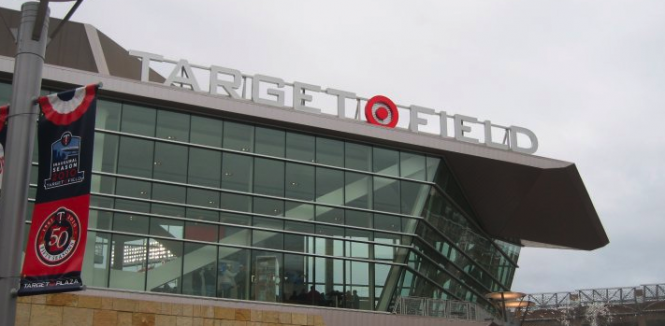Boy, do I love Target Field, the new baseball stadium for the Minnesota Twins. It's a gorgeous place, offering great views from every seat (so I've heard -- I've only sampled a few) and easy access to the rest of downtown Minneapolis. Seeing the Twins play outside makes me feel like a kid again, and I wonder if my children will look forward to trips to Target Field with the same excitement I had when my parents made the drive from Long Island, where I grew up, to Yankee Stadium.
Target Field somehow feels both entirely new and utterly, wonderfully Minnesotan. Bob Dylan's "Like a Rolling Stone" blares from the speakers in between innings. The downtown skyline twinkles behind the home run fence. And the food is, in a way, Minnesotan too.
I know I'm not alone in thinking that one of the great joys of a new stadium is the opportunity to explore the food. Gone are the days of Ball Park Franks and Bud Light; now when we go to the ball park, we eat Kosher sandwiches and sushi. I remember visiting Coors Field in Denver just after it was built, but I don't remember the game at all. The highlights for me were seeing the mountains from behind home plate and sampling Rocky Mountain oysters for the first (and only) time. So when I made my first trek to Target Field, I was excited to see what delightful delectables awaited.
Much has been written about the stadium's emphasis on "local food." On the KARE 11 website, Janel Klein wrote that:
Going to the concession stands is like taking a local food tour. All your favorites from the State Fair are here, plus things like Juicy Lucy burgers, JD Hoyt's pork chops, Byerly's soup and Loon Cafe chili. Even Tony Oliva's cooking on the concourse, selling a special Cuban steak sandwich he's calling Tony O's.
Jessica Mador from Minnesota Public Radio wrote:
There is a big emphasis on local foods with Minnesota history [...] Along with nachos and Budweiser, fans here can find hometown favorites like Juicy Lucy burgers, Murray's steak sandwiches and Summit Beer.
 In the May issue of Mpls/St. Paul Magazine, local food icon Andrew Zimmern wrote:
In the May issue of Mpls/St. Paul Magazine, local food icon Andrew Zimmern wrote:
... the food at Target Field is a huge home run. It's locally sourced to the extreme: Wild Acres turkey legs, Loon Cafe chili, J.D.Hoyt's pork chops, Caribou Coffee, Vincent's short-rib and Gouda-stuffed burger, Kramarczuk's sausages (yes, plural!). Even organic farmers' market items like local apples will debut in the fall... there's a "hundred mile" menu available through the catering department for locavores with access to suites and private dining.
I'll admit it; I've been to only two games, and I have not yet explored the "hundred mile" menu (nor have I heard of it, apart from this excerpt. Hey Twins! If you're listening, let me in!) And while I patiently wait for the appearance of local, organic apples this fall, right now I'm a little bit confused by the words local food.
What Is Local Food?
All this talk about local food at Target Field begs the question of what exactly the term local food means. Is local food what you eat at a local restaurant? Is it what you buy from the local grocery store? Does the support local businesses movement support the local food movement? Is local food sold at "independent businesses"? Is local food what we want to eat, or are we really more concerned with food that is organic, pesticide-free, fair-trade, or sustainably grown? Can you eat local food at a national restaurant?
Here's what Wikipedia tells us about locavores:
A locavore is someone who eats food grown or produced locally or within a certain radius such as 50, 100, or 150 miles (240 km). The locavore movement encourages consumers to buy from farmers' markets or even to produce their own food, with some arguing that fresh, local products are more nutritious and taste better. Locally grown food is an environmentally friendly means of obtaining food, since supermarkets that import their food use more fossil fuels and non-renewable resources.
For locavores, the food must not only be prepared locally, but sourced locally too. In many cases, locavores may be less concerned with supporting our local economy than they are with knowing exactly where and how the food was produced, and how many miles it traveled to get to the plate.
The difference between knowing who prepared your food and who produced it can be enormous, and the task of tracing our food back to its source can be difficult or impossible. (Check out the article "Your Taco, Deconstructed" from GOOD Magazine to see what I mean). Many of us turn to intermediaries for help: restaurants, grocery stores, co-ops, and sites like Simple, Good, and Tasty. They make our lives easier by doing the research, or even the procuring and preparing, for us. Locally produced food can be easier to trace, and it can be easier to get answers to our questions about animal husbandry and growing practices from local farmers than their counterparts in the industrial system.
If our goal is to keep more money in our community, eating food from local farms helps, too. Sure, we can support the local fast-food joint (big box retailer, auto dealer, etc.) and celebrate the fact that it's putting people in our communities to work, but how many more jobs in our community would be supported if these businesses bought their food from a local farm? And what if the farm paid a living wage? How much would it help our community then?
Many terrific, independent restaurants serve conventionally produced food. How much more could they be doing for our community if they bought even 10 percent of their ingredients locally, in season?
Is the Food at Target Field Local?
I'm not keen to take on Andrew Zimmern, MPR, or KARE 11, but I do think it's worth pointing out that many of the "local foods" mentioned above would make a locavore cringe. For example, although I absolutely love the taste of Kramarczuk's sausages, when I called to ask where their food came from, they told me it was from a variety of sources. "What if I only want to eat meat from animals that were treated well?" I asked. "I'm sorry," they said, "unfortunately, we can't promise that."
Then I called Vincent, one of the finest restaurants in the city, to ask where the beef for their delicious burger comes from. "Conventional farms," the man on the phone told me, "we buy a lot of food locally when we can, but the burgers we serve at Target Field are definitely not from local cows."
I could go on. Caribou Coffee? Tony Oliva's cuban sandwiches? Well, they're local in a way that's not unimportant. These institutions keep Minnesotans employed, keep dollars in our state, and generally make Minnesota a better place to be. But should we eat their food?
To Eat, or Not to Eat? That is the Question
What you eat is your own business, of course. My goal is not to keep you from enjoying the foods you love, the terrific experience of outdoor baseball at Target Field, Bob Dylan, Minnesota institutions, Tony O, or your mom's apple pie. My goal is, very simply, to get you to think.
There is a difference between food that is prepared and served in our state, and food that is raised here. There is also a difference between food that is raised here conventionally -- generally corn-fed and pesticide-laden -- and food that is raised here by farmers who favor sustainable, fair-trade, humane, and/or organic practices. That difference doesn't matter to everyone, but it's significant. I want delicious food on my plate, and I want to feel good about how it got there.
And so I end this piece with a series of questions, rather than answers. Is it enough for a business to be locally based? Is it enough for a business to provide tasty food, regardless of the source? What does calling the food at Target Field "local" say about ourselves, our values, and our state? Will you eat it either way?
Please let me know - I'd love to hear from you.

Lee Zukor is the founder of Simple, Good, and Tasty. Email him at lee@simplegoodandtasty.com or follow him on Twitter.




